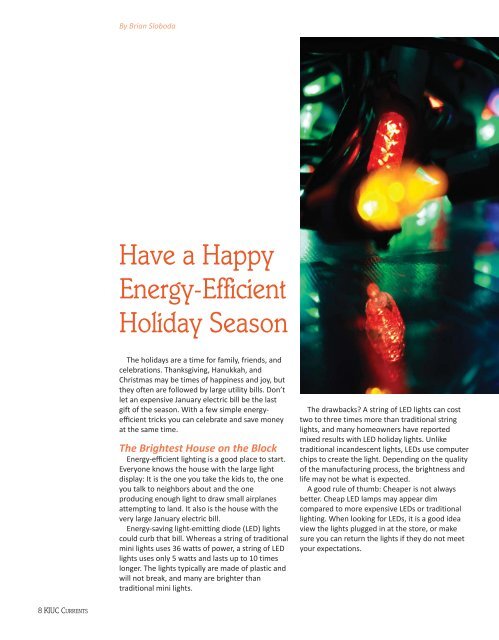Safer is Smarter - Kauai Island Utility Cooperative
Safer is Smarter - Kauai Island Utility Cooperative
Safer is Smarter - Kauai Island Utility Cooperative
Create successful ePaper yourself
Turn your PDF publications into a flip-book with our unique Google optimized e-Paper software.
8 KIUC CURRENTS<br />
By Brian Sloboda<br />
Have a Happy<br />
Energy-Efficient<br />
Holiday Season<br />
The holidays are a time for family, friends, and<br />
celebrations. Thanksgiving, Hanukkah, and<br />
Chr<strong>is</strong>tmas may be times of happiness and joy, but<br />
they often are followed by large utility bills. Don’t<br />
let an expensive January electric bill be the last<br />
gift of the season. With a few simple energyefficient<br />
tricks you can celebrate and save money<br />
at the same time.<br />
The Brightest House on the Block<br />
Energyefficient lighting <strong>is</strong> a good place to start.<br />
Everyone knows the house with the large light<br />
d<strong>is</strong>play: It <strong>is</strong> the one you take the kids to, the one<br />
you talk to neighbors about and the one<br />
producing enough light to draw small airplanes<br />
attempting to land. It also <strong>is</strong> the house with the<br />
very large January electric bill.<br />
Energysaving lightemitting diode (LED) lights<br />
could curb that bill. Whereas a string of traditional<br />
mini lights uses 36 watts of power, a string of LED<br />
lights uses only 5 watts and lasts up to 10 times<br />
longer. The lights typically are made of plastic and<br />
will not break, and many are brighter than<br />
traditional mini lights.<br />
The drawbacks? A string of LED lights can cost<br />
two to three times more than traditional string<br />
lights, and many homeowners have reported<br />
mixed results with LED holiday lights. Unlike<br />
traditional incandescent lights, LEDs use computer<br />
chips to create the light. Depending on the quality<br />
of the manufacturing process, the brightness and<br />
life may not be what <strong>is</strong> expected.<br />
A good rule of thumb: Cheaper <strong>is</strong> not always<br />
better. Cheap LED lamps may appear dim<br />
compared to more expensive LEDs or traditional<br />
lighting. When looking for LEDs, it <strong>is</strong> a good idea<br />
view the lights plugged in at the store, or make<br />
sure you can return the lights if they do not meet<br />
your expectations.
















